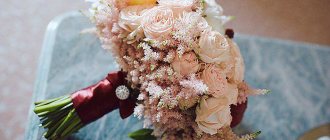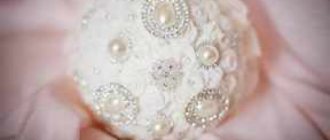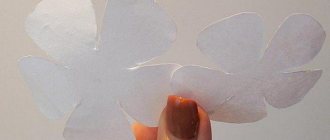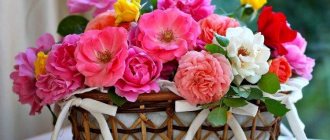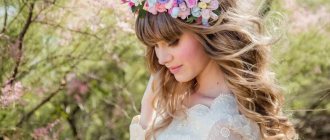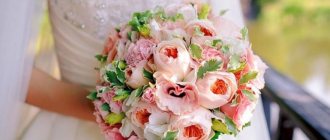There are many requirements for a bride's bouquet: it must match the wedding dress, it must be comfortable to hold in your hands - and sometimes you also have to throw a wedding bouquet, as a tribute to tradition. There are also boutonnieres for the groom and bridesmaids - also made from fresh flowers. Which bridal bouquet will look best in wedding photographs? How to combine it with a boutonniere? Florist advises.
The meaning of boutonniere
Translated from French, boutonniere (la boutonniere) means “flower in the buttonhole.” Despite the fact that even in ancient times, men decorated their clothes with flowers, the accessory became widespread only in the 17th-18th centuries; miniature flower arrangements symbolized the high social status of the wearer and demonstrated his wealth. Until the beginning of the 20th century, not a single self-respecting gentleman went out without this decorative element.
The accessory is a small floral arrangement (single flower or miniature bouquet), which is attached to the buttonhole on a men's suit. It is usually made from live or artificial inflorescences, buds, and decorated with leaves, twigs, dried flowers, and berries.
The size of the composition should not exceed 10 cm including the peduncle.
Such an accessory serves as a symbol of natural beauty, combined with the fragility of human life and masculinity.
Traditions
The history of wedding boutonnieres can be traced back to the times of Ancient Rome. The girls took out one flower from the wedding bouquet, which they attached to the grooms’ clothes. Such a gesture was considered a manifestation of love. The ancient Greeks also decorated wedding clothes: the groom’s suit had to have a bouquet of flowers and herbs protecting him from evil spirits.
The tradition of wedding boutonnieres appeared in the 19th century in Great Britain. At the wedding of royalty Albert and Victoria, the groom took a flower from his future wife's bouquet, which he used to decorate the buttonhole of his suit. Many people believe that this is just a beautiful legend, but since then not a single wedding has been complete without a boutonniere.
Signs
Many wedding superstitions are associated with the groom's boutonniere. It is common among people to respond to omens, so it is better to get to know them:
- The boutonniere is attached to the left side, closer to the heart.
- You need to secure the accessory to your clothing using a safety pin, the head of which is pointing down. This helps protect against the evil eye. But no one should see the pin itself.
- During the ceremony of removing the veil from the bride, a young couple is chosen from among those present. The girl is put on a veil, and the guy “inherits” a boutonniere from the groom. It is believed that if this guy and girl are in love with each other, then they will certainly get married soon.
- It is believed that the veil and boutonniere cannot be given to anyone. Therefore, for the above-mentioned tradition, the bride and groom usually order copies of their accessories. The originals should be kept as a family heirloom.
What it is
Content
The word itself comes from the French Boutonniere, which literally translates as “flower in the buttonhole.” The name is associated with the peculiarities of fastening the decoration - European dandies wore it exclusively on the left lapel of their jacket.
Modern wedding boutonnieres have become a wide field for florists to realize their imagination. The use of the accessory is no longer limited to the groom’s suit:
- It is attached to the bride's dress and to the outfits of witnesses.
- Festive tables or cards with the names of guests are decorated with similar decor.
- Miniature compositions worn on the hand often replace a bridal bouquet.
- If desired, these lovely, exquisite bouquets of flowers can also be used for all guests.
Boutonnieres have different meanings; in the wedding tradition, they symbolize loving hearts and their unity.
Types of accessory
Boutonnieres for a wedding celebration are divided into two main categories:
- Simple - usually made up of one large flower, which is complemented by small decorative details (green twigs, ribbon). The center of the composition is selected in accordance with the bride's bouquet. Flowers must be repeated. But in some cases, you can only duplicate the color or texture. When the bouquet palette is not limited to one color, you need to choose the shade that looks most advantageous and contrasts against the background of the jacket. You also need to choose hardy plants (calla lilies, roses).
- Complex - this category includes composite compositions of classical or eco-styles. For traditional boutonnieres, miniature tulips or callas, spray roses and other flowers with compact buds are used. They are collected in a small bouquet, which is complemented with gypsophila or bergasse, and tied with a satin ribbon. Such compositions are suitable not only for the groom, but also for bridesmaids and guests.
READ
Wedding champagne – alcohol and a work of art
For the groom
The boutonniere adorning the lapel of the groom's jacket attracts as many eyes as his fiancée's bouquet. Therefore, stylists recommend paying special attention to this accessory. The design of the composition should be based on the following:
- The boutonniere should correspond to the overall style of the ceremony and fit harmoniously.
- Flowers must match the bride's bouquet. It is optimal if they are the same or similar in size and shade.
- The boutonniere must be firmly attached to the suit. Flowers inserted into the buttonhole must be additionally secured with a pin.
- The composition should not be too bright. It is better not to use large size and abundant decoration.
If the accessory is made of fresh flowers, you should make sure that they do not stain your clothes. Some buds are distinguished by an abundance of pollen, which can remain on the jacket or stain the bride's dress.
When creating a composition, you can base it on one of the design options:
- Mono-flower - rose or peony, iris or chrysanthemum, orchid or tulip.
- Mini-bouquet - several buds of the same size or one large flower surrounded by smaller greenery inflorescences.
- Brooch - similar accessories are suitable for weddings in a glamorous style.
To the witness
A boutonniere for a witness is not a mandatory accessory, but with its help you can emphasize the status of the guest, as well as emphasize the solemnity of the event.
The only limitation when creating such a floral arrangement is the requirement to match the groom’s decoration. In this case, the bouquets should not be repeated; a more modest option is selected for the witness, but using the same flowers.
Bridesmaids
Boutonnieres for bridesmaids should be a miniature copy of the bouquet of the main hero of the occasion, but do not have to repeat its shape. For example, you can make original boutonniere bracelets, decorate hairpins, headbands, handbags or belts with compositions.
Guests
Boutonnieres for guests are also optional. But with their help, you can emphasize the special status of some invitees, for example, relatives or close friends. Accessories should be modest, made in the same style and color scheme as the main accessories of the bride and groom.
On your hand or on your dress?
Brides who decide to use a boutonniere often ask a similar question. And it is simply impossible to answer it unequivocally. After all, each representative of the fair sex has her own priorities.
There is only one thing to say: a decoration on your hand is much more convenient than a bouquet on a dress. After all, the outfit is already beautiful in its own way and it has enough accessories. A boutonniere is attached to a robe only if the design of the dress allows it.
Manufacturing Features
For the groom, a floral accessory is created based on the following materials:
- Fresh flowers - natural decoration looks elegant and natural. It is difficult to maintain its original appearance and freshness throughout the celebration. In this case, florists recommend making 2-3 identical copies to be able to refresh the image.
- Artificial flowers are a practical decoration that is well suited if the wedding is organized during the winter season. The bouquet will not stain clothes and will not wither.
- Foamiran is a soft polymer material, the flowers from which look naturalistic. The texture of the material is delicate, visually the buds are no different from real ones, they look gentle and elegant.
- Ribbons - flower buds are made of satin using the kanzashi technique. You can create a flower of any shape, focusing on pastel colors and simple shapes.
- Organza - floral compositions are original and light. Organza can also be replaced with mesh or chiffon. This boutonniere will be complemented by beads, crystals, feathers, and decorative berries.
- Silk - using this material you can imitate buds, leaves, and create realistic and durable compositions.
- Polymer clay is a hard material that requires baking. The colored mass is given the desired shapes and shapes, and after hardening, a boutonniere is formed from ready-made elements. The composition is attached to a wire frame.
READ
Wedding decor – attention to detail for an unforgettable celebration
The note! A simple technique will help preserve the freshness of a natural boutonniere. The stem of each flower is cut diagonally and then dipped in melted wax.
With your own hands
If possible, it is better to entrust the making of a wedding bouquet and boutonniere to a professional florist. The price of the product will depend on the complexity of the work and the materials used. But brides who enjoy crafting can practice making their own accessories. This method will be inexpensive and will also allow you to demonstrate your creative talents to your guests.
The simplest options can be made with your own hands from fresh or artificial flowers. But if desired, the materials can be replaced with textiles, ceramics, clay, and the composition can be supplemented with spectacular decor.
To avoid any problems when creating a boutonniere, you should use ready-made ideas and master classes that describe the entire process step by step.
In the cabin
By ordering a boutonniere in a wedding salon or from a professional florist, you can buy an original and high-quality accessory. Often designers violate the traditional approach when creating such floral arrangements, preferring to perform thematic ones:
- For a wedding in a rustic style, combinations of dried flowers, berries, ears of corn with burlap and lace, and buttons are used.
- The maritime celebration will be complemented by a boutonniere decorated with pearls, shells, corals, and twine, made in white and blue tones.
- Autumn weddings are not complete without accessories made using dried flowers, conifers, bright berries (currants, barberries), pine cones and leaves.
- A celebration in the steampunk style can become inspiration for creating a boutonniere based on some mechanism, for example, a watch.
- If your wedding style is minimalist, you should limit yourself to a simple boutonniere of one flower of a discreet color without unnecessary decor.
How to make a bridal bouquet yourself?
Thanks to the wide opportunities of the present time, future wives can learn how to make wedding paraphernalia in special thematic courses. Detailed photos and video master classes will allow those who want to learn how to make beautiful decorations from flowers, without spending the family budget, to make their dreams come true.
Thanks to photographs of bouquets, you can see what result you should expect. Perhaps each bride will add something from herself, making the bouquet truly original and unique.
Don't know where to start and how to make a wedding bouquet with your own hands?
The information of interest is described in as much detail as possible in thematic materials on the wedding services portal svadebka.ws. Don't be afraid to be original on your own wedding day! Hide description
Necessary materials
To make a boutonniere from fresh flowers you will need to prepare the following materials:
- Plant material (buds, leaves, twigs, berries).
- Decorative elements (ribbons, beads, rhinestones, feathers).
- Floral wire and tape.
- Scissors.
Before starting work, it is recommended to place the flower in cold water for 3-4 hours, this will help prolong its freshness.
The stem of the flower is cut diagonally almost at the base of the bud. A hole is carefully made in the remainder of the stem, into which a wire folded in half is inserted.
You need to assemble the composition in such a way that it is flat on one side, which will be adjacent to the lapel. This is necessary for ease of fastening. For the latter, pins, hairpins are used, and in some cases the bouquet is simply sewn to the jacket fabric. Traditionally, this is done by the bride.
Fastening rules
You need to attach the boutonniere to the jacket correctly. Moreover, the rules differ for the groom and guests:
- The composition is attached to the groom's left lapel with a pin. To prevent it from being visible, the top is masked with a decorative mesh, beads or bow.
- Male guests can attach the boutonniere directly to their shirt, vest or cardigan. The choice of side depends on marital status. Married guests hang boutonnieres on the right, single guests on the left. The same applies to the bridesmaids.
Boutonniere raffle at a wedding
The tradition of the bride throwing her bouquet and garter is very popular. The garter was usually thrown to the groom's friends, but it can be replaced with a boutonniere. In this case, it is worth making the accessory in duplicate in advance.
You can come up with competitions to win this detail. For example, the prize will be given to the person who dances the best to receive it. The newlyweds should come up with tasks. You can also hide a bouquet, and whoever finds it will find family happiness.
Whatever the boutonniere, you need to think through all the details in advance so that the composition looks harmonious and does not stand out from the overall concept of the celebration. You can select materials, colors and shapes either independently or with the help of experienced florists.
Video: master class on making a rose boutonniere
Some newlyweds would like to keep some accessories as a souvenir from the wedding. A flower arrangement could also be such an item. But what to do with a flower if it withers within a short time? Dry it? The color may be lost, and over time the bouquet will crumble. There is a wonderful solution: make an artificial boutonniere with your own hands, better if together.
This decoration will keep your warmth and love for many years. After watching the video, you can see that anyone can do this art. Step-by-step video instructions describe in detail all stages of work. The shade of the petals can be varied, depending on the intended color scheme of the wedding and its style. With a little effort, you will get a wonderful accessory.

